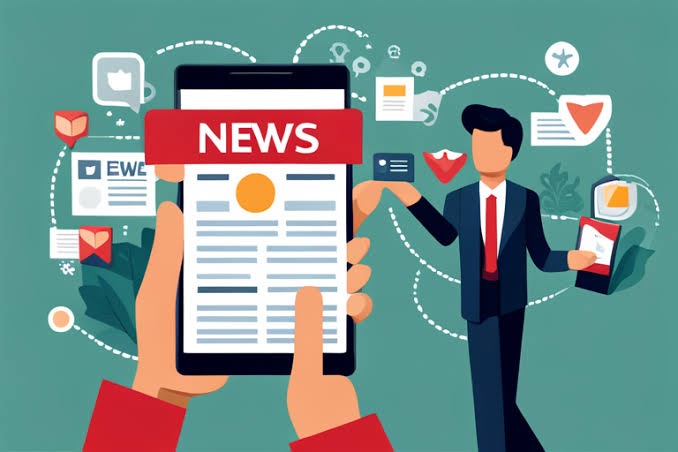Smartphones have revolutionized how people consume news and information in the digital age. With their widespread adoption and powerful capabilities smartphones have become primary devices. They are used for accessing news content. This has reshaped traditional journalism practices and influenced the way news is produced. It has also impacted how news is distributed and consumed globally.
The proliferation of smartphones has significantly increased accessibility and immediacy of news. Unlike traditional media such as newspapers or television, which are bound by physical distribution. And broadcasting schedules smartphones provide instantaneous access to news updates anytime anywhere. This accessibility has fueled the rise of mobile news consumption. It has made news content more readily available to a broader audience.
One key impact of smartphones on news consumption is the unparalleled convenience they offer. Users can access news websites. They use apps and social media platforms directly from their smartphones with just a few taps. This ease of access enables people to stay informed throughout the day. Whether they are commuting waiting in line, or relaxing at home they can access news. The portability of smartphones ensures that news is no longer confined to specific times or locations, empowering users to consume news on their own schedules.
Real-time Updates and Notifications
Smartphones enable real-time news updates and notifications, delivering breaking news and important developments directly to users' devices. News apps and mobile websites send push notifications to alert users about significant events, ensuring that they are informed about the latest developments as they unfold. This real-time aspect of smartphone news consumption enhances the immediacy and relevance of the information received, keeping users up-to-date with current events.
Shift in Consumption Habits
The prevalence of smartphones has led to a shift in how people consume news. Traditional forms of media, such as print newspapers and television, have seen declines in readership and viewership, particularly among younger demographics who favor digital and mobile sources. Smartphones cater to evolving consumer preferences for on-demand access to personalized news content, which can be customized based on interests and browsing history.
Impact on Journalism Practices
The rise of smartphones has not only transformed news consumption habits but also impacted journalism practices and the way news is produced and disseminated.
Mobile-First Journalism
Journalists and news organizations have adopted a mobile-first approach to reach smartphone users effectively. This involves optimizing news content for mobile devices, including responsive design, mobile-friendly formats, and fast-loading pages. Mobile-first journalism prioritizes user experience on smartphones, ensuring that news articles, videos, and multimedia content are accessible and engaging on smaller screens.
Multimedia Storytelling
Smartphones have facilitated the rise of multimedia storytelling in journalism. Journalists use smartphones to capture high-quality photos and videos directly from the field, providing visual context and immediacy to news stories. Social media platforms like Instagram, Snapchat, and TikTok have become popular channels for sharing multimedia content, allowing journalists to reach new audiences and engage with readers through visual storytelling.
User-generated Content and Citizen Journalism
Smartphones empower ordinary citizens to participate in news reporting through user-generated content and citizen journalism. With built-in cameras and recording capabilities, smartphone users can capture and share photos, videos, and eyewitness accounts of news events in real-time. Social media platforms serve as channels for distributing user-generated content, enabling rapid dissemination and amplification of news stories from multiple perspectives.
Challenges and Considerations
While smartphones have democratized access to news and transformed journalism practices, they also present challenges and considerations for both consumers and journalists.
Information Overload and Filter Bubbles
The abundance of news sources and digital content available on smartphones can lead to information overload and filter bubbles. Information overload occurs when users are overwhelmed by the sheer volume of news updates and struggle to discern credible sources from misinformation or clickbait. Filter bubbles refer to the personalized news feeds generated by algorithms based on users' preferences and browsing history, potentially limiting exposure to diverse viewpoints and perspectives.
Trust and Credibility
The proliferation of user-generated content on smartphones raises concerns about the credibility and reliability of news sources. Misinformation, fake news, and viral hoaxes can spread rapidly through social media and messaging apps, undermining trust in traditional journalism and authoritative news sources. Journalists and news organizations face the challenge of verifying information and maintaining editorial standards in an era of rapid digital dissemination.
Privacy and Data Security
Smartphones collect vast amounts of personal data, including location information, browsing history, and app usage patterns. News apps and websites may track user behavior to personalize content and deliver targeted advertisements. Privacy concerns arise regarding the unauthorized access, misuse, or exploitation of personal data by third parties. Journalists and news organizations must navigate privacy regulations and ethical considerations when collecting and utilizing user data for news reporting and audience engagement.
Conclusion
Smartphones have had a profound impact on news consumption habits, journalism practices, and the media landscape as a whole. They have democratized access to news, offering unparalleled convenience, real-time updates, and personalized content experiences for users. Journalists and news organizations have embraced mobile-first strategies, leveraging smartphones for multimedia storytelling, citizen journalism, and audience engagement. However, smartphones also present challenges such as information overload, filter bubbles, trust issues, and privacy concerns that require careful consideration and mitigation strategies. As technology continues to evolve, smartphones will continue to shape the future of news consumption and journalism, influencing how information is produced, distributed, and consumed in an increasingly digital and interconnected world.
